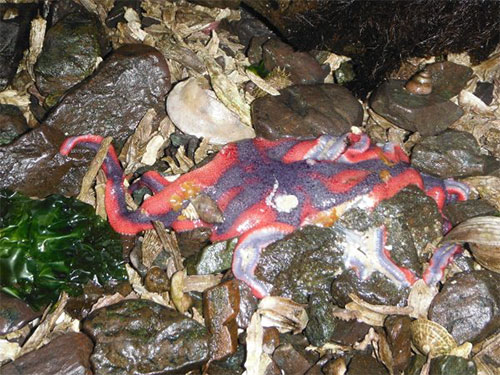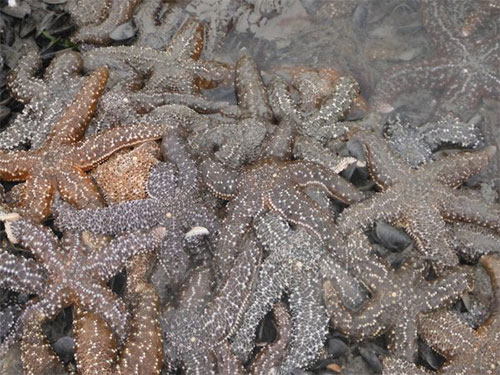
Wasting disease devastates Kachemak Bay sea star populationsBy LAUREN FRISCH
May 08, 2017
This is likely the aftermath of a sea star wasting disease episode. The disease causes lesions, and may result in the loss of arms, making a sea star look as if it is melting or decomposing. Similar episodes have been spreading across the southern coast of Alaska and as far south as Baja California. “In spring 2016 we counted 180 sea stars during our intertidal surveys, which was high in the books,” said Brenda Konar, a professor at the University of Alaska Fairbanks College of Fisheries and Ocean Sciences. “Just one year later, we counted only five sea stars.”
A sea star with wasting disease lies on Kachemak Bay’s shore in spring 2016. Wasting disease caused this star’s arm to disconnect from its body.
Their transect lines are small subsections of the intertidal at various locations around Kachemak Bay. They are used to represent the entire bay. These snapshots are helpful, because you can’t measure every beach in Kachemak Bay. By monitoring these transect lines every year, Iken and Konar can get a sense of how the bay is changing over time. Sea stars are important top predators in intertidal ecosystems. They help keep prey populations in check, which helps maintain species diversity. Without sea stars, the kinds of species that dominate these intertidal communities could change. “We will have to keep monitoring this area to see any long-term changes,” Iken said. “It could be that the prey of sea stars, such as mussels, limpets or chitons become more abundant, or maybe other predators become more abundant for at least awhile.” It’s hard to gauge what normal numbers are, especially since 2016 was a big year for sea stars. But Konar explained that sea stars can usually be found all over Kachemak Bay. In 2015, 64 sea stars were reported along the transect lines, and 76 were reported in 2014. “We don’t know why numbers spiked last year, or if it’s related to the drop we saw this year,” Konar said.
Mottled sea stars cover a portion of the Gulf Watch Diversity of sea stars along the transect lines also dropped from seven species in 2016 to two species in 2017. Previous years had five or six species along these lines. This year the researchers saw leather stars and blood stars, which are known to be more resilient to wasting disease than other species. “The spread of the disease to Alaskan waters and its impact on sea star diversity may be related to the unprecedented warm waters that we experienced in the Gulf of Alaska in the past two years,” Iken said. But things might look up in the future. Konar explained that sea stars started disappearing from intertidal zones off the coast of Washington, Oregon and California in 2014. Recently, baby sea stars are starting appearing again, and populations are rebounding. “We’re at the height of this episode right now,” Konar said, “but we’re not suggesting that these regions will never have sea stars again. Kachemak Bay may just have a few years before we start seeing any kind of recovery.” More information on this research can be found at the Ecological Trends in Kachemak Bay Gulf Watch project website.
This article is provided as a public service by the University of Alaska Fairbanks College of Fisheries and Ocean Sciences.
Representations of fact and opinions in comments posted are solely those of the individual posters and do not represent the opinions of Sitnews.
|
||

